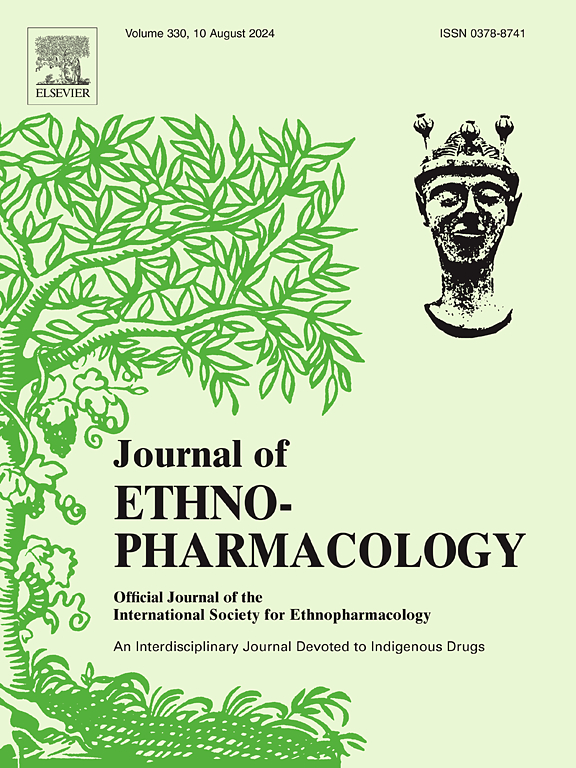Unveiling the gastroprotective effect of the ethyl acetate fraction of Cordia africana Lam. roots against ethanol-induced gastric ulcer and Helicobacter pylori
IF 4.8
2区 医学
Q1 CHEMISTRY, MEDICINAL
引用次数: 0
Abstract
Ethnopharmacological relevance
Traditionally, Cordia africana Lam. roots, have been used in the treatment of gastro-intestinal complaints and the management of peptic ulcer diseases.
Aim of the study
Quantitative determination of Cordia africana Lam. roots constituents was performed to investigate their phytochemical composition and their anti-ulcer mechanism.
Materials and methods
Cordia africana Lam. roots were subjected to extraction and fractionation. Antimicrobial activities of the extract and its factions were tested against Helicobacter pylori, and minimum inhibitory concentration (MIC) was measured. Then, an in vivo ethanol-induced model in rats was performed (at two tested doses: 200 mg/kg, 400 mg/kg, and pantoprazol 10 mg/kg against ethanol 5 mL/kg by oral gavage) with subsequent histopathological analysis. Oxidative and gastric inflammatory markers were measured. The phytochemical profile was confirmed using quantitative High-performance liquid chromatography (HPLC). Finally, molecular docking was performed to investigate the binding mode among the most abundant quantified compounds, viz., kaempferol, myricetin, naringenin, quercetin, and rosmarinic acid and three chosen proteins.
Results
Among the tested fractions, Cordia africana ethyl acetate fraction (CAEt) gave the least MIC (7.82 μg/mL). Besides, at its high dose (400 mg/kg; orally), CAEt significantly reduced the ulcer number and severity by 26 % each, lowered malondialdehyde by 39 %, and increased glutathione and prostaglandin E2 levels by 92 % and 27 %, respectively, compared to pantoprazol. It exhibited similar potency to pantoprazol in decreasing tumor necrosis factor-alpha and cytokine-induced neutrophil chemoattractant-1, while it significantly decreased nuclear factor-kappa B more than pantoprazol by 7 %. Nineteen compounds were quantified using HPLC, showing that phenolic compounds and flavonoids were the most abundant phytoconstituents. In-silico molecular docking screening revealed the interaction between the five most quantified compounds and nuclear factor kappa B, prostaglandin E2, and tumor necrosis factor alpha proteins.
Conclusion
CAEt possesses potent gastroprotective properties via the reduction of gastric ulcer severity, decreasing oxidative stress, and inflammatory markers in ethanol-induced stomach damage. CAEt could be a promising candidate for gastric ulcer treatment and further studies on gastric-related diseases.

揭示非洲山茱萸乙酸乙酯部位的胃保护作用。抗乙醇性胃溃疡和幽门螺杆菌
民族药理学相关性:传统意义上,非洲考迪亚。根,已用于胃肠道疾病的治疗和消化性溃疡疾病的管理。目的研究非洲蛇舌草的含量测定方法。以根成分为研究对象,探讨其植物化学成分及其抗溃疡机制。材料与方法非洲天竺葵。根进行提取和分馏。测定了提取物及其各组分对幽门螺杆菌的抑菌活性,并测定了最低抑菌浓度(MIC)。然后建立大鼠体内乙醇诱导模型(分别以200 mg/kg、400 mg/kg和泮托拉唑10 mg/kg对乙醇5 mL/kg灌胃两种剂量),并进行组织病理学分析。测量氧化和胃炎症指标。采用高效液相色谱法(HPLC)对植物化学谱进行了分析。最后,进行分子对接,研究山奈酚、杨梅素、柚皮素、槲皮素、迷迭香酸等最丰富的定量化合物与选定的三种蛋白之间的结合模式。结果非洲荆芥乙酸乙酯部位(CAEt)的MIC最低,为7.82 μg/mL;此外,在高剂量(400mg /kg;口服),与泮托拉唑相比,CAEt显著降低溃疡数量和严重程度,分别降低26%,降低丙二醛39%,增加谷胱甘肽和前列腺素E2水平,分别提高92%和27%。降低肿瘤坏死因子α和细胞因子诱导的中性粒细胞趋化因子-1的作用与泮托拉唑相似,而降低核因子κ B的作用比泮托拉唑高7%。用高效液相色谱法对19种化合物进行了定量分析,结果表明酚类化合物和黄酮类化合物含量最高。计算机分子对接筛选揭示了5种定量最多的化合物与核因子κ B、前列腺素E2和肿瘤坏死因子α蛋白之间的相互作用。结论caet具有较强的胃保护作用,可减轻胃溃疡严重程度,降低氧化应激,降低乙醇性胃损伤的炎症指标。CAEt在胃溃疡治疗和胃相关疾病的进一步研究中具有广阔的应用前景。
本文章由计算机程序翻译,如有差异,请以英文原文为准。
求助全文
约1分钟内获得全文
求助全文
来源期刊

Journal of ethnopharmacology
医学-全科医学与补充医学
CiteScore
10.30
自引率
5.60%
发文量
967
审稿时长
77 days
期刊介绍:
The Journal of Ethnopharmacology is dedicated to the exchange of information and understandings about people''s use of plants, fungi, animals, microorganisms and minerals and their biological and pharmacological effects based on the principles established through international conventions. Early people confronted with illness and disease, discovered a wealth of useful therapeutic agents in the plant and animal kingdoms. The empirical knowledge of these medicinal substances and their toxic potential was passed on by oral tradition and sometimes recorded in herbals and other texts on materia medica. Many valuable drugs of today (e.g., atropine, ephedrine, tubocurarine, digoxin, reserpine) came into use through the study of indigenous remedies. Chemists continue to use plant-derived drugs (e.g., morphine, taxol, physostigmine, quinidine, emetine) as prototypes in their attempts to develop more effective and less toxic medicinals.
 求助内容:
求助内容: 应助结果提醒方式:
应助结果提醒方式:


